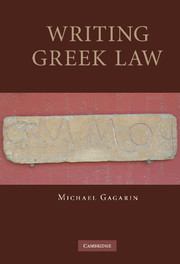Book contents
- Frontmatter
- Contents
- List of illustrations
- Preface and Acknowledgments
- List of abbreviations
- Introduction: Writing Greek Law
- Chapter 1 Law before Writing
- Chapter 2 Writing and Written Laws
- Chapter 3 Why the Greeks Wrote Laws
- Chapter 4 Why Draco Wrote his Homicide Law
- Chapter 5 Oral and Written in Archaic Greek Law
- Chapter 6 Writing Laws in Fifth-Century Gortyn
- Chapter 7 Writing the Gortyn Code
- Chapter 8 Writing Law in Classical Athens
- Chapter 9 Writing Athenian Law: a Comparative Perspective
- Chapter 10 Writing Law in Hellenistic Greece
- Conclusion: Writing Greek Law
- Appendices
- Bibliography
- Index Locorum
- Subject Index
Chapter 3 - Why the Greeks Wrote Laws
Published online by Cambridge University Press: 22 September 2009
- Frontmatter
- Contents
- List of illustrations
- Preface and Acknowledgments
- List of abbreviations
- Introduction: Writing Greek Law
- Chapter 1 Law before Writing
- Chapter 2 Writing and Written Laws
- Chapter 3 Why the Greeks Wrote Laws
- Chapter 4 Why Draco Wrote his Homicide Law
- Chapter 5 Oral and Written in Archaic Greek Law
- Chapter 6 Writing Laws in Fifth-Century Gortyn
- Chapter 7 Writing the Gortyn Code
- Chapter 8 Writing Law in Classical Athens
- Chapter 9 Writing Athenian Law: a Comparative Perspective
- Chapter 10 Writing Law in Hellenistic Greece
- Conclusion: Writing Greek Law
- Appendices
- Bibliography
- Index Locorum
- Subject Index
Summary
To understand why the Greeks wrote these early laws we must ask several questions: Who wrote the laws? Who read them? What kinds of laws were written? What effect does putting a rule into written form have on that rule? The physical features of the inscriptions examined in Chapter Two suggest answers to some of these questions; for others we will have to look more closely at the content of laws and their social and historical context.
I begin with the vexing question, who could read these early texts? As we saw (Chapter Two), during the first century (ca. 750–650), when writing was used only for private inscriptions, these inscriptions were written, and presumably read, by a range of people including some who were not members of the elite. We also noted that, beginning around 650, archaic laws were displayed in easily accessible public spaces, were often written in large clear letters suitable for reading, and almost always contained features like word-division markers that would make the text easier to read and understand. These physical features strongly suggest that the laws were intended to be read, but this does not tell us by whom. It is tempting to conclude that the readers of archaic laws included the same broad range of people as the writers of the earliest private inscriptions, but there are at least two potential obstacles to this conclusion. First, the widespread popularity of writing during its first century may not have continued in subsequent years.
- Type
- Chapter
- Information
- Writing Greek Law , pp. 67 - 92Publisher: Cambridge University PressPrint publication year: 2008



